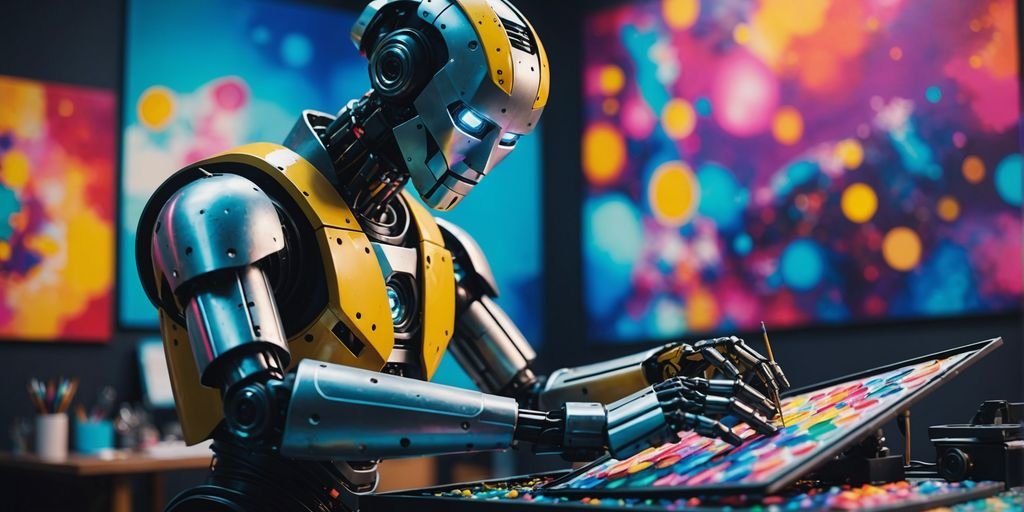Generative AI is rapidly transforming the creative landscape, and at the forefront of this revolution is DALL-E 3. This cutting-edge AI model developed by OpenAI is breaking down traditional barriers in the creative industries, empowering artists, designers, and content creators to explore new horizons of artistic expression and innovation. By generating high-quality images from textual descriptions, DALL-E 3 is not only democratizing creativity but also reshaping workflows across various sectors, from marketing and advertising to film and gaming. In this article, we delve into how DALL-E 3 is revolutionizing creative industries and what this means for the future of visual media and entertainment.
Key Takeaways
- DALL-E 3 democratizes creativity by making high-quality visual content accessible to both professionals and novices, removing traditional barriers to entry.
- The integration of DALL-E 3 into creative workflows enhances efficiency and fosters innovation, transforming sectors such as marketing, advertising, and entertainment.
- While DALL-E 3 offers unprecedented opportunities, it also raises important ethical considerations, including intellectual property concerns and the balance between human and AI creativity.
The Genesis of DALL-E and Its Creative Disruption
DALL-E’s technology harnesses the power of advanced machine learning algorithms to interpret and visualize textual prompts into detailed images. This process involves a complex interplay of data analysis, pattern recognition, and a vast database of visual references, enabling the AI to produce images that range from realistic renderings to surreal compositions.
At its core, DALL-E democratizes creativity, offering both seasoned professionals and novices alike the tools to bring their wildest imaginations to life. This paradigm shift raises pivotal questions about the role of human creativity in an increasingly automated world. As we delve deeper into the era of generative AI, the creative industries stand at a crossroads, poised to redefine the essence of artistic expression and innovation.
Breaking Down Technical Barriers
DALL-E has managed to break down significant technical barriers that previously limited the scope of AI-generated art. By leveraging vast datasets and sophisticated algorithms, it can create images that are not only highly detailed but also contextually relevant. This has opened up new avenues for artists and designers, allowing them to explore creative possibilities that were once unimaginable.
Empowering a New Generation of Artists
One of the most exciting aspects of DALL-E is its ability to empower a new generation of artists. With its user-friendly interface and powerful capabilities, even those with little to no artistic training can create stunning visual content. This democratization of art-making tools is fostering a more inclusive creative community, where diverse voices and perspectives can flourish.
Shifts in Creative Skill Demands
The advent of DALL-E is also causing shifts in the demands for creative skills. Traditional skills like drawing and painting are being complemented by new competencies in AI and machine learning. Artists are now required to understand how to work with AI tools to enhance their creative processes. This shift is not about replacing human creativity but augmenting it, offering new ways to express artistic vision.
Revolutionizing Creative Workflows
The integration of DALL-E into creative workflows marks a significant evolution in how projects are conceptualized and executed. This AI tool not only accelerates the ideation phase but also introduces a level of versatility and experimentation previously unattainable with traditional methods.
Transforming Visual Media and Entertainment
The impact of DALL-E extends beyond traditional art and design, venturing into the realms of visual media and entertainment. This AI’s ability to generate detailed and contextually relevant images from textual descriptions offers exciting possibilities for content creation across various platforms, including film, television, gaming, and online media.
Challenges and Ethical Considerations
As with any innovative technology, challenges and ethical considerations must be addressed when implementing generative AI in creative work. Ensuring that generative AI is not employed in ways that could detrimentally impact society is a responsibility that companies must uphold. To protect community and vulnerable populations, policymakers should take proactive steps to:
Conclusion
As we navigate the transformative landscape of generative AI, DALL-E 3 stands out as a pivotal force reshaping the creative industries. By democratizing access to high-quality creative tools, it empowers both seasoned professionals and novices to push the boundaries of artistic expression. While challenges and ethical considerations remain, the potential for human-AI collaboration heralds a new era of innovation and creativity. The future of creative industries lies in leveraging these advanced tools to complement human ingenuity, fostering a symbiotic relationship that enhances, rather than diminishes, the essence of human creativity.
Frequently Asked Questions
How is generative AI transforming creative sectors?
Generative AI like DALL-E is empowering artists and designers, reshaping societal norms, and fostering innovative human-machine collaborations.
Will DALL-E impact creative careers?
DALL-E’s commercial use poses both opportunities and challenges, potentially transforming creative work but not necessarily killing creative careers.
How does DALL-E affect filmmakers and designers?
At its core, DALL-E democratizes creativity, offering both seasoned professionals and novices alike the tools to bring their wildest imaginations to life. This paradigm shift raises pivotal questions about the role of human creativity in an increasingly automated world.



